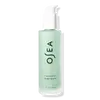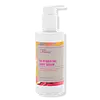What's inside
What's inside
 Key Ingredients
Key Ingredients

 Benefits
Benefits

 Concerns
Concerns

No concerns
 Ingredients Side-by-side
Ingredients Side-by-side

Water
Skin ConditioningPropanediol
SolventPropanediol Dicaprylate/Caprate
EmollientGlycerin
HumectantCoconut Alkanes
EmollientSpirulina Platensis Extract
Skin ProtectingNiacinamide
SmoothingCaffeine
Skin ConditioningAmmonium Acryloyldimethyltaurate/Vp Copolymer
Betaine
HumectantHaematococcus Pluvialis Extract
AntioxidantHaematococcus Pluvialis Oil
AntioxidantCodium Fragile Extract
Skin ConditioningAloe Barbadensis Leaf Juice
Skin ConditioningSodium Hyaluronate
HumectantHydrolyzed Glycosaminoglycans
HumectantHydrolyzed Hyaluronic Acid
HumectantHyaluronic Acid
HumectantTremella Fuciformis Polysaccharide
Emulsion StabilisingPolyglutamic Acid
Skin ConditioningLactobacillus Ferment
Skin ConditioningCoco-Caprylate/Caprate
EmollientCetearyl Olivate
Sorbitan Olivate
Emulsifying1,2-Hexanediol
Skin ConditioningXanthan Gum
EmulsifyingEthylhexylglycerin
Skin ConditioningTrisodium Ethylenediamine Disuccinate
Citric Acid
BufferingPotassium Sorbate
PreservativeCaprylhydroxamic Acid
Sodium Benzoate
MaskingPhenoxyethanol
PreservativeCopper Chlorophyll
Cosmetic ColorantWater, Propanediol, Propanediol Dicaprylate/Caprate, Glycerin, Coconut Alkanes, Spirulina Platensis Extract, Niacinamide, Caffeine, Ammonium Acryloyldimethyltaurate/Vp Copolymer, Betaine, Haematococcus Pluvialis Extract, Haematococcus Pluvialis Oil, Codium Fragile Extract, Aloe Barbadensis Leaf Juice, Sodium Hyaluronate, Hydrolyzed Glycosaminoglycans, Hydrolyzed Hyaluronic Acid, Hyaluronic Acid, Tremella Fuciformis Polysaccharide, Polyglutamic Acid, Lactobacillus Ferment, Coco-Caprylate/Caprate, Cetearyl Olivate, Sorbitan Olivate, 1,2-Hexanediol, Xanthan Gum, Ethylhexylglycerin, Trisodium Ethylenediamine Disuccinate, Citric Acid, Potassium Sorbate, Caprylhydroxamic Acid, Sodium Benzoate, Phenoxyethanol, Copper Chlorophyll
Water
Skin ConditioningPanthenol
Skin ConditioningPropanediol
SolventCoco-Caprylate/Caprate
EmollientGlycerin
HumectantAmmonium Acryloyldimethyltaurate/Vp Copolymer
Glyceryl Glucoside
HumectantCaprylyl Glyceryl Ether
CleansingGlyceryl Stearate Se
EmulsifyingHydrogenated Lecithin
EmulsifyingPolyglutamic Acid
Skin ConditioningSodium Hyaluronate
HumectantCaprylhydroxamic Acid
Capryloyl Salicylic Acid
ExfoliatingBeta-Glucan
Skin ConditioningTrisodium Ethylenediamine Disuccinate
Water, Panthenol, Propanediol, Coco-Caprylate/Caprate, Glycerin, Ammonium Acryloyldimethyltaurate/Vp Copolymer, Glyceryl Glucoside, Caprylyl Glyceryl Ether, Glyceryl Stearate Se, Hydrogenated Lecithin, Polyglutamic Acid, Sodium Hyaluronate, Caprylhydroxamic Acid, Capryloyl Salicylic Acid, Beta-Glucan, Trisodium Ethylenediamine Disuccinate
 Reviews
Reviews

Ingredients Explained
These ingredients are found in both products.
Ingredients higher up in an ingredient list are typically present in a larger amount.
Ammonium Acryloyldimethyltaurate/Vp Copolymer (let's call it AAVC for short) is a synthetically created polymer. It's used as a film-forming agent and used to thicken the consistency of products.
AAVC is able to increase the consistency and viscosity of products due to its large molecule size. It also prevents ingredients from separating.
Caprylhydroxamic Acid is a chelating agent.
Chelating agents help prevent metal ions from binding to other ingredients. This helps prevent unwanted reactions and effects from using the product.
Caprylhydroxamic Acid is often used with natural antimicrobial products as an alternative to preservatives.
Learn more about Caprylhydroxamic AcidCoco-Caprylate/Caprate is created from fatty coconut alcohol, caprylic acid, and capric acid.
It is a lightweight emollient. Emollients create a thin barrier on the skin to trap moisture in. This helps keep your skin hydrated and soft.
Once applied, Coco-Caprylate/Caprate is absorbed quickly and leaves a silky feel.
Coco-Caprylate/Caprate may not be fungal acne safe.
Learn more about Coco-Caprylate/CaprateGlycerin is already naturally found in your skin. It helps moisturize and protect your skin.
A study from 2016 found glycerin to be more effective as a humectant than AHAs and hyaluronic acid.
As a humectant, it helps the skin stay hydrated by pulling moisture to your skin. The low molecular weight of glycerin allows it to pull moisture into the deeper layers of your skin.
Hydrated skin improves your skin barrier; Your skin barrier helps protect against irritants and bacteria.
Glycerin has also been found to have antimicrobial and antiviral properties. Due to these properties, glycerin is often used in wound and burn treatments.
In cosmetics, glycerin is usually derived from plants such as soybean or palm. However, it can also be sourced from animals, such as tallow or animal fat.
This ingredient is organic, colorless, odorless, and non-toxic.
Glycerin is the name for this ingredient in American English. British English uses Glycerol/Glycerine.
Learn more about GlycerinPolyglutamic Acid is made up many glutamic acids chained together. It is created from bacterial fermentation.
This ingredient is an effective skin hydrator and may help speed up wound healing. As a humectant, it draws and holds water to the skin. This ingredient is often compared to hyaluronic acid or glycerin. Similarly to hyaluronic acid, it can vary in molecular weights. This means polyglutamic acid is capable of bringing hydration to lower levels of the skin.
Fun fact: Polyglutamic Acid is found in the Japanese food, natto. It is also being used in cancer treatment studies.
Learn more about Polyglutamic AcidPropanediol is an all-star ingredient. It softens, hydrates, and smooths the skin.
It’s often used to:
Propanediol is not likely to cause sensitivity and considered safe to use. It is derived from corn or petroleum with a clear color and no scent.
Learn more about PropanediolSodium Hyaluronate is hyaluronic acid's salt form. It is commonly derived from the sodium salt of hyaluronic acid.
Like hyaluronic acid, it is great at holding water and acts as a humectant. This makes it a great skin hydrating ingredient.
Sodium Hyaluronate is naturally occurring in our bodies and is mostly found in eye fluid and joints.
These are some other common types of Hyaluronic Acid:
Learn more about Sodium HyaluronateTrisodium Ethylenediamine Disuccinate is used to help stabilize a product.
It is a chelating agent, meaning it helps prevent metal ions from binding to other ingredients. This prevents unwanted reactions in products. Metal ions can come into a product via the water ingredient. They are found in trace amounts and are not known to be harmful.
Water. It's the most common cosmetic ingredient of all. You'll usually see it at the top of ingredient lists, meaning that it makes up the largest part of the product.
So why is it so popular? Water most often acts as a solvent - this means that it helps dissolve other ingredients into the formulation.
You'll also recognize water as that liquid we all need to stay alive. If you see this, drink a glass of water. Stay hydrated!
Learn more about Water